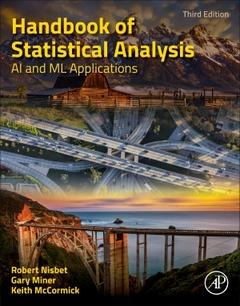Handbook of Statistical Analysis (3rd Ed.) AI and ML Applications
Auteurs : Nisbet Robert, Miner Gary D., McCormick Keith

Handbook of Statistical Analysis: AI and ML Applications, third edition, is a comprehensive introduction to all stages of data analysis, data preparation, model building, and model evaluation. This valuable resource is useful to students and professionals across a variety of fields and settings: business analysts, scientists, engineers, and researchers in academia and industry. General descriptions of algorithms together with case studies help readers understand technical and business problems, weigh the strengths and weaknesses of modern data analysis algorithms, and employ the right analytical methods for practical application. This resource is an ideal guide for users who want to address massive and complex datasets with many standard analytical approaches and be able to evaluate analyses and solutions objectively. It includes clear, intuitive explanations of the principles and tools for solving problems using modern analytic techniques; offers accessible tutorials; and discusses their application to real-world problems.
1. Historical Background to Analytics
2. Theory
3. Data Mining and Predictive Analytic Process
4. Data Science Tool Types: Which one is Best?
Part II - Data Preparation
5. Data Access
6. Data Understanding
7. Data Visualization
8. Data Cleaning
9. Data Conditioning
10. Feature Engineering
11. Feature Selection
12. Data Preparation Cookbook
Part III – Modeling
13. Algorithms
14. Modeling
15. Model Evaluation and Enhancement
16. Ensembles & Complexity
17. Deep Learning vs. Traditional ML
18. Explainable AI (XAI) put after Deep Learning
19. Human in the Loop
Part IV - Applications
20. GENERAL OVERVIEW of an Application - Healthcare Delivery and Medical Informatics
21. Specific Application: Business: Customer Response
22. Specific Application: Education: Learning Analytics
23. Specific Application: Medical Informatics: Colon Cancer Screening
24. Specific Application: Financial: Credit Risk
25. Specific FUTURE Application: The ‘INTELLIGENCE AGE (Revolution)’: LLMs like ChatGPT - Tiny ML - H.U.M.A.N.E. - Etc.
Part V – Right Models – Luck - & Ethics of Analytics
26. Right Model for the Right Use
27. Ethics in Data Science
28. Significance of Luck
Part VI - Tutorials and Case Studies
Tutorial A Example of Data Mining Recipes Using Statistica Data Miner 13
Tutorial B Analysis of Hurricane Data (Hurrdata.sta) Using the Statistica Data Miner 13
Tutorial C Predicting Student Success at High-Stakes Nursing Examinations (NCLEX) Using SPSS Modeler and Statistica Data Miner 13
Tutorial D Constructing a Histogram Using MidWest Company Personality Data Using KNIME
Tutorial E Feature Selection Using KNIME
Tutorial F Medical/Business Tutorial Using Statistica Data Miner 13
Tutorial G A KNIME Exercise, Using Alzheimer’s Training Data of Tutorial F (RAN note: This tutorial refers to the data used in Tutorial I, and it should be changed to refer to Tutorial F. I propose a new title: Tutorial G Medical/Business Tutorial with Tutorial F Data Using KNIME.
Tutorial H Data Prep 1-1: Merging Data Sources Using KNIME
Tutorial I Data Prep 1–2: Data Description Using KNIME
Tutorial J Data Prep 2-1: Data Cleaning and Recoding Using KNIME
Tutorial K Data Prep 2-2: Dummy Coding Category Variables Using KNIME
Tutorial L Data Prep 2-3: Outlier Handling Using KNIME
Tutorial M Data Prep 3-1: Filling Missing Values With Constants Using KNIME
Tutorial N Data Prep 3-2: Filling Missing Values With Formulas Using KNIME
Tutorial O Data Prep 3-3: Filling Missing Values With a Model Using KNIME
Back Matter:
Appendix-A – Listing of TUTORIALS and other RESOUCES on this book’s COMPANION WEB PAGE
Appendix B – Instructions on HOW TO USE this book’s COMPANION WEB PAGE
Dr. Gary Miner PhD received a B.S. from Hamline University, St. Paul, MN, with biology, chemistry, and education majors; an M.S. in zoology and population genetics from the University of Wyoming; and a Ph.D. in biochemical genetics from the University of Kansas as the recipient of a NASA pre-doctoral fellowship. He pursued additional National Institutes of Health postdoctoral studies at the U of Minnesota and U of Iowa eventually becoming immersed in the study of affective disorders and Alzheimer's disease.
In 1985, he and his wife, Dr. Linda Winters-Miner, founded the Familial Alzheimer's Disease Research Foundation, which became a leading force in organizing both local and international scientific meetings, bringing together all the leaders in the field of genetics of Alzheimer's from several countries, resulting in the first major book on the genetics of Alzheimer’s disease. In the mid-1990s, Dr. Miner turned his data analysis interests to the business world, joining the team at StatSoft and deciding to specialize in data mining. He started developing what eventually became the Handbook of Statistical Analysis and Data Mining Applications (co-authored with Drs. Robert A. Nisbet and John Elder), which received the 2009 American Publishers Award for Professional and Scholarly Excellence (PRO
- Brings together, in a single resource, all the information a beginner needs to understand the tools and issues in data analytics to build successful predictive analytic solutions
- Provides in-depth descriptions and directions for performing many data preparation operations necessary to generate data sets in the proper form and format for submission to modeling algorithms
- Features clear, intuitive explanations of standard analytical tools and techniques and their practical applications
- Provides a number of case studies to guide practitioners in the design of analytical applications to solve real-world problems in their data domain
- Offers valuable tutorials on the book webpage with step-by-step instructions on how to use suggested tools to build models
- Provides predictive insights into the rapidly expanding “Intelligence Age” as it takes over from the “Information Age,” enabling readers to easily transition the book’s content into the tools of the future
Date de parution : 09-2024
Ouvrage de 650 p.
21.5x27.6 cm
Thèmes de Handbook of Statistical Analysis :
Mots-clés :
<; p>; business data; statistical analysis; CRISP-DM; SEMMA text mining; Clementine interface<; /p>



